
In April of 2014, I site-volunteered for DASH, once again using it as an excuse to travel someplace new. This year, that place was Davis CA, the university town between San Francisco and Sacramento.
DASH6 sites:
On April 6, I headed up for a playtest. Thus, I got to meet many of the folks who'd be GC site volunteers; also, I'd get to see the puzzles and the sites. Who was there?
I found out that Davis could be hot and humid: I felt faint at one point, probably dehydrated; I drank at least a bottle and a half of water over the course of the day. I learned that UCD's Arboretum was pretty, with plants and art and students performing more art. We weren't even the weirdest thing going on in the arboretum that day.
We playtested puzzles. Some cities had playtested the weekend before; a city had playtested the day before. One puzzle got yanked from the main flow and converted to a bonus puzzle perhaps half an hour before we were supposed to solve it. We got "nerfed" versions of puzzles that had been too difficult at previous playtests; we confirmed that these simpler versions were not too hard.
I site-volunteered for DASH on April 26, but I got into town a couple of days early and left a day late so I could see more of Davis. Not knowing exactly what I wanted to see, I mostly went looking for Munzees, barcodes hidden around town. I was glad I gave myself time to look around; Davis was pretty awesome.
Close to campus, Davis' bike paths were striking; streams of students pedaling past. Further from campus, the bike paths seemed empty. I walked from subdivision to subdivision, encountering well-maintained bikepaths. It was as if the city had grown larger than what one could pedal without becoming a Serious Bicyclist, but still instinctively insisted on putting bikepaths everywhere. (Later, I talked with Jason Zhang about Davis. He figured that Davis' layout was a symptom of wealth. The city could afford to keep up the landscaping around those bike paths because Davis had money, more than a typical suburb.) I walked through subdivisions; past fields not yet turned to subdivisions; through shopping areas. On Friday, the day before the game, it rained. Partway through that day, I gave up on walking outside and headed back to to my hotel to read until the rain stopped—and by the time that happened, it was late enough such that I just stayed in.
Downtown had a lot of public art: murals, statues. Campus had more. Much of the art reminded me of UCD's background as an ag school. On campus, tiles on the sidewalk made an artwork, Elements of Life—a tile for each of the periodic elements, many of them shown tying into biology or medicine. At Mace Park, the similarly titled Evidence of Life. Tile mosaics on the columns of a building illustrated concepts from plant biology. Not that I needed the art to remind me of ag school; my hotel was next a building of USDA research offices; signs on campus welcomed people to a conference on Western Irrigation; there were cows on campus and horses, too. Plants abounded; as did allergies and plant-matter blown into irrirated eyes. One public statue was a giraffe; unlike San Mateo's this one was not named Leon and was thus of less interest to puzzlehuntists. If my schedule had been different, I could have seen the pedal-powered carousel (The Flying Carousel of the Delta Breeze) in action; I could have seen the Bicycling Hall of Fame.
Of the things I saw, probably my favorite was the Arboretum. I saw some of it during the playtest. When Dan A heard I'd liked it, he suggested that I see more of it; that turned out to be pretty good advice. Art, plants, bridges, more plants, interpretive text about plants, plants; a good way to see plenty of pretty plants without actually having to trek through the wilderness.
Before the game, plaza north of MU
Much of GC: Scott, Jason, Dan, Andrew, Paul (obsfured),
Matt, Matt's better half, Daniel

Teams gather: Rachel of the Walkin' Eds tracks down Dwight;
The Kings of Tokyo (presumably boardgamers), GC, mini-Golems
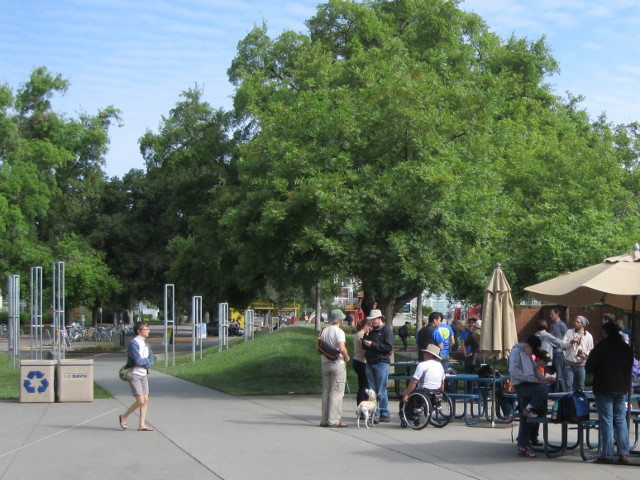
Teams I don't know so well
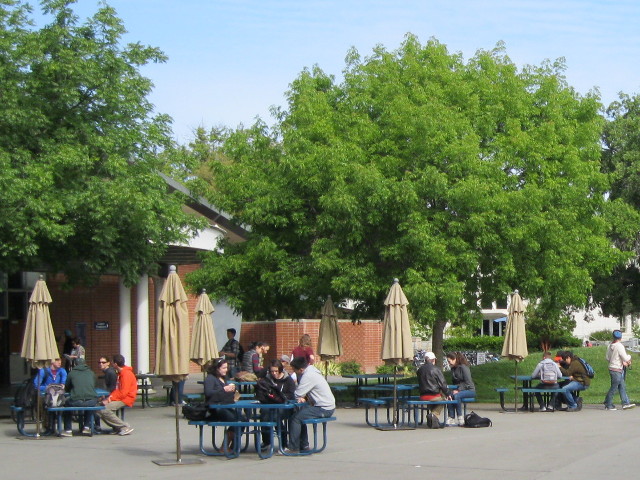
Not shown: Team Feral Tofu, the fastest Experienced team playing in Davis that year, featuring Robert Au who I'd played with in DASH 1.
Site: King Lounge, sort of
In theory, Jason and I were to set up at King Lounge, inside the MU. In practice, the King Lounge was locked, so we stayed in the hall.
Our station was the second of the game. We were by windows that
looked north, at the plaza that was the first station of the game.
I was scared to be visible in the window, lest teams spot us.
(This wouldn't really have altered the game; but would perhaps be
considered bad form.) So rather than peek out the window, I stayed
out of site and peeked out the window via the reflection in a pane
of glass.
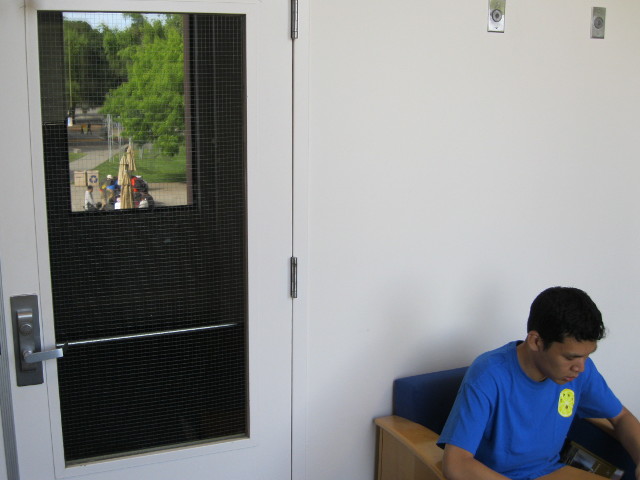
When things calmed down outside, Paul came by to check on us.
During the day, Paul was a "floater"; he wasn't watching any
site in particular, but went from place to place. If you were
the only one watching a site and needed a break, he could take
over for a few minutes.
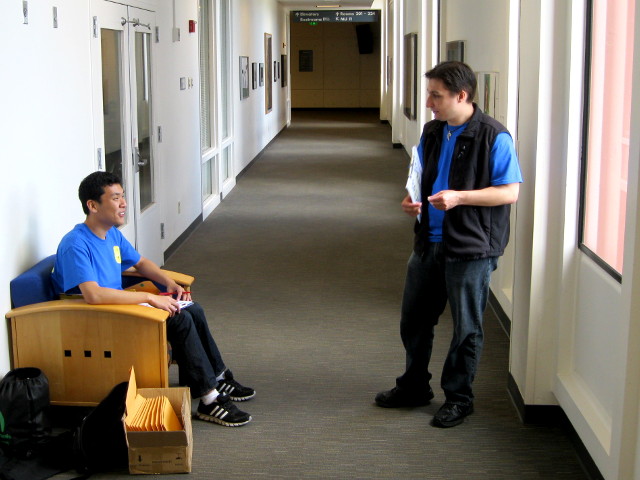
Since we were locked out of the King Lounge, many teams went into the
next door
Art Lounge to sit and solve. Here we see Paul popping in for another visit.
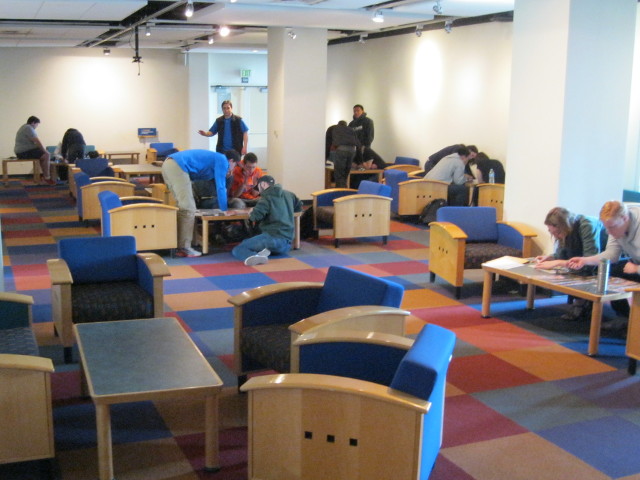
I wandered around and checked on teams, but didn't help any out: I figured that the new Cluekeeper automatic hint-dispensing system would take care of them. Then one team staggered out, and said that they'd decided to skip the puzzle after having struggled with it for an hour. So… the automatic hint system wasn't 100% perfect at keeping teams on track. Why had I assumed it would be?
It occurred to me that Brent Holden of Shinteki (longtime user of automatic hinting) would occasionally wander over to offer a nudge to struggling, straggling teams. Maybe I should take a lesson from Brent. The last couple of teams on the lounge weren't totally lost—but they'd made little errors and were looking at gibberish. "Oh hey, double check that letter" was enough to straighten them out and dispel frustration.
Site: Student Community Center
My next site was at the Student Community Center. This was one of the last puzzles in the hunt, so I had a couple of hours to catch up on my reading before Dan A. showed up. And we had more time to sit around before teams started showing up.
Dan Alcantara got some close-up duck photos. You should ask him about his
duck photos, because now he has some amazing ones.
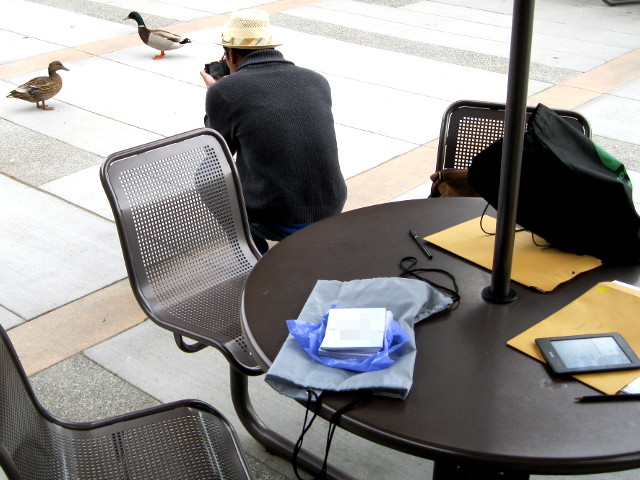
This year had a Junior Track: teams of kids could play, accompanied by a
chaperone. So
Joe Fendel
ferried his kids and other kids up from the
bay area to Davis so that he could…not actually, play but rather
watch these kids play. I had my doubts that the kids would stick with
it, but here they were hours into the game, proving me wrong. The bad
news was that the Junior version of the puzzle hadn't got so much testing.
In fact the junior version of this puzzle was pretty broken.
(Thanks to a Junior team in an early time zone (NYC?) that gave us plenty
of warning about this one.)

Site: The Graduate
When the last of our teams had left, Dan A and I were dispatched to the patio of The Graduate, a bar near campus. Teams who finished the hunt would being sent there for a post-game gathering. We sat around for an hour… and no teams showed up. Which just goes to show that Davis' team have a similar feeling about post-game parties to mine ("It's time to exhaustedly collapse after all that adrenaline rush"). Or maybe it was all the bay area teams wanting to get a head start on driving back home. When the rest of GC showed up, I headed back to my hotel to show my sympathy for the exhaustedly-collapse teams.